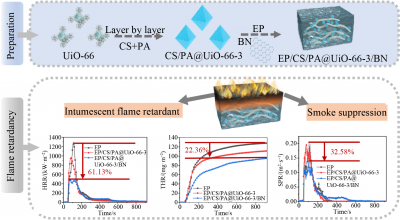Researchers from Jiangnan University have conducted a study entitled “Influence of a novel biobased coating decorated with UiO-66/BN in persistent flame-retardant hybrids on the fire safety and thermal degradation of epoxy resin”. This study was published in Frontiers of Chemical Science & Engineering, Volume 19, Issue 5.
To increase the fire safety of epoxy resin, this study employed a layer-by-layer self-assembly method to prepare a biologically flame-retardant coating-modified zirconium-based metal-organic framework (chitosan/phytic acid (CS/PA) @UiO-66). This study also attempted to incorporate boron nitride (BN) to enhance the flame-retardant properties of epoxy resin composites. The results from Fourier transform infrared spectroscopy, X-ray diffraction, and scanning electron microscopy confirmed the successful synthesis of UiO-66 and illustrated the assembly of CS and PA onto UiO-66 through a self-assembly strategy. Thermogravimetric analysis in conjunction with cone calorimetry and Raman spectroscopy analyses indicated that incorporating biologically-based flame-retardant coating-modified CS/PA@UiO-66 and BN nanosheets could effectively increase the flame-retardant performance of epoxy composites. Compared with pure epoxy resin, the incorporation of CS/PA@UiO-66-3 and CS/PA@UiO-66-3/BN led to a reduction in the peak heat release rate and total heat release values of 61.13% and 22.36% for EP/CS/PA@UiO-66-3 and EP/CS/PA@UiO-66-3/BN, respectively. Notably, EP/CS/PA@UiO-66-3/BN presented a continuous and dense char layer surface with increased graphite arrangement and higher residual char content after thermal degradation and combustion, thereby providing effective suppression of heat, mass, and oxygen transfer, demonstrating promising flame-retardant efficacy. Consequently, this study successfully improved the fire safety of epoxy resin and presented a new approach for the use of biologically-based flame-retardants.
For more detailed information, the full paper is available at: https://journal.hep.com.cn/fcse/EN/10.1007/s11705-025-2545-2.
